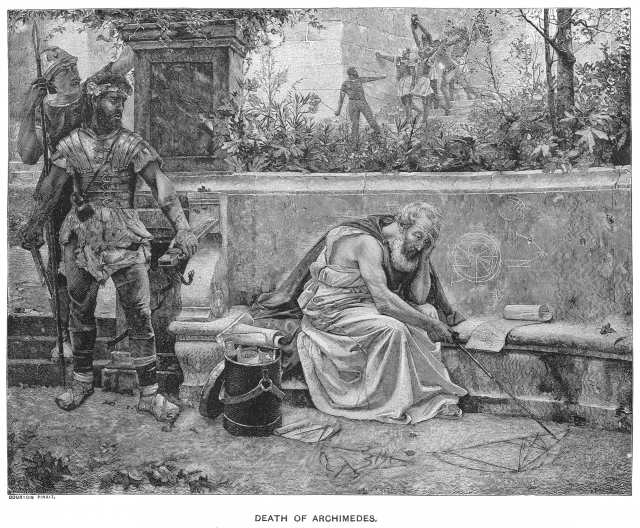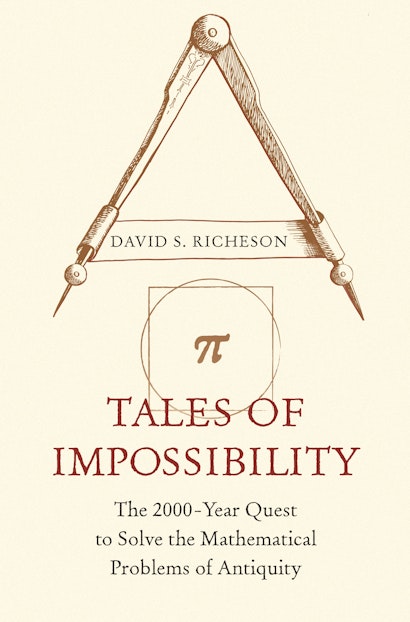Tales of Impossibility recounts the intriguing story of the so-called ‘problems of antiquity,’ four of the most famous and studied questions in the history of mathematics. First posed by the ancient Greeks, these compass and straightedge problems—squaring the circle, trisecting an angle, doubling the cube, and inscribing regular polygons in a circle—have served as ever-present muses for mathematicians for more than two millennia. David Richeson follows the trail of these problems to show that ultimately, their proofs—demonstrating the impossibility of solving them using only a compass and straightedge—depended upon and resulted in the growth of mathematics.
When did you first learn the story of the problems of antiquity, and what was your initial reaction to these famous tales?
DR: I took an introductory abstract algebra course when I was a sophomore in college. The course was designed with the express purpose of proving these geometric impossibility theorems (and one other—the insolvability of the quintic). It was an exciting slow build from the beginning of the semester until the final climactic conclusion. It was one of the first times that I saw how many different areas of mathematics could be brought together to prove a deep and important theorem. It was not obvious at the outset that the abstract ideas in algebra could be used to prove a theorem about geometry.
What inspired you to write the book?
DR: I continued to be fascinated by these problems for years after I learned about them, and I thought it was unfortunate that they were accessible only to people who were deep into a mathematics major. Plus, with my interest in the history of mathematics, I knew the story of their resolution was fascinating and was interwoven with the history of mathematics as a whole. After doing some preliminary research, I realized that it was possible to present these problems and their history to a general readership. I also discovered that although the problems of antiquity were among the most famous problems in the history of mathematics, there was a gap in the literature. This book, which presents the mathematics and the history of the problems for a general audience, had not been written by anyone. I was determined to be that person.
How would you describe the problems of antiquity to somebody who may not be familiar with mathematics?
DR: These problems are similar to the geometry problems that kids learn in high school—by using only a compass and a straightedge, draw a line parallel to a given line through a given point, draw the perpendicular bisector of a line segement, and so on. The problems of antiquity are just as easy to state as these homework problems, but they are impossible to solve. For instance, it is possible to bisect an arbitrary angle, but it is impossible to trisect it. It is possible to draw a regular pentagon, but it is impossible to construct a regular heptagon (a 7-sided polygon). The most famous of these impossibility problems is the problem of squaring the circle; it is impossible to draw, using only these Euclidean tools, a circle with the same area as a given square.
Why did it take so long for mathematicians to determine that these problems were unsolvable?
DR: These problems are easy to state, but for many years, geometers were unable to solve them. At some point there was a general consensus that they were probably impossible to solve, but mathematicians did not have to tools needed to prove the impossibility (it may not have even occurred to them that this was something that could be proved). The eventual proofs of impossibility required new mathematics—mathematical tools that the Greek geometers did not have available to them. The world had to wait for the invention of analytic geometry, algebra, calculus, complex numbers, a deep understanding of π, and even some number theory to be able to prove that the problems are impossible.
What was your research process like for this book?
DR: A lot of reading. As the reader can see, the bibliography of my book is massive. These problems were so famous for so long and they are so beloved in the mathematical community that there was a lot written about them. I read everything I could. I also had many conversations with mathematicians and math historians whose offhand comments and suggestions often sent my research off in new and unexpected directions. In fact, there were so many fascinating side stories connected to these problems that I put a short mini-chapter, which I call a “Tangent,” in between each main chapter of the book. These Tangents cover topics such as geometric origami constructions, the story of digit hunters who tried to compute the decimal expansion of π, the geometric work of Harold and the Purple Crayon author Crocket Johnson, and the infamous Indiana π bill.
What can math enthusiasts get out of reading this book? What about those who may not be as familiar with math?
DR: Math enthusiasts will enjoy learning about these famous problems and seeing how they fit into the general historical progression of mathematics. They will meet the many mathematicians who contributed to the story—a virtual who’s who of mathematics. Readers who are less familiar with mathematics and its history will find much of this story new, but I believe that even professional mathematicians, math historians, and knowledgeable math enthusiasts will learn a lot about these fascinating problems and their history.
David S. Richeson is professor of mathematics at Dickinson College and editor of Math Horizons. He is the author of Euler’s Gem: The Polyhedron Formula and the Birth of Topology (Princeton). Twitter @divbyzero

